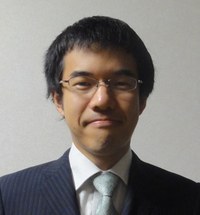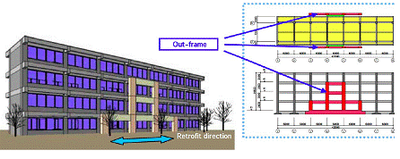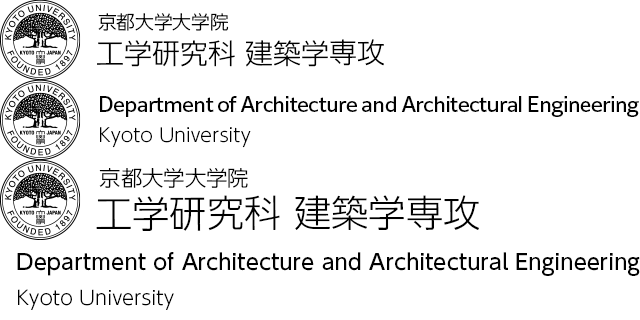Structural Dynamics of Buildings
In addition to the conventional seismic-resistant design technologies, innovative seismic-control technologies are inevitable to guarantee the safety of building structures under uncertain earthquake ground motions. In these technologies, it is necessary to know the dynamic properties of constructed building structures from limited information and utilize it effectively in the actual seismic retrofit. The seismic retrofit of building structures with small seismic strengths is an important issue to be resolved at once. This laboratory is trying to resolve this problem. The other research topics include the inverse problem-based design of buildings under soil-structure interaction and critical excitation methods in earthquake engineering.
Research activities in English are encouraged and education of engineers and researchers with broad perspectives are promoted.
Academic Staff
Yoshikazu ARAKI
 Professor (Graduate School of Engineering)
Professor (Graduate School of Engineering)
Research Topics
- Assessment and control of seismic collapse capacity of buildings
- Vibration control of buildings using new types of shape memory alloys
- Pioneering new materials, devices, structural systems, and construction techniques toward enhanced safety and sustainability of buildings
Contacts
Room 382, C1-Building, C-Cluster, Katsura Campus
TEL: 075-383-3294
E-mail: araki![]() archi.kyoto-u.ac.jp
archi.kyoto-u.ac.jp
Kohei FUJITA
 Associate Professor (Graduate School of Engineering)
Associate Professor (Graduate School of Engineering)
Research Topics
- Earthquake-resistant Design for Bi-Directional Ground Motion
- Optimal Design Method for Seismically Controlled Structure
- Robust Design by Uncertainty Analysis Method
- System Identification and Structural Health Monitoring
Contacts
Room 381, C1-Building, C-Cluster, Katsura Campus
TEL: 075-383-3295
FAX: 075-383-3297
E-mail: fm.fujita![]() archi.kyoto-u.ac.jp
archi.kyoto-u.ac.jp
Research Topics
Inverse Problem-Based Design Method for Building Structures under Dynamic Soil-Structure Interaction
In the current structural design of buildings, it is important to consider soil conditions and properties adequately and explicitly. This requirement has been introduced explicitly in the Japanese Building Standard Law revised in 2000. However, this requirement has never been satisfied completely in the actual structural design of buildings.
Takewaki and co-workers have proposed an inverse problem-based design method for building structures under dynamic soil-structure interaction in order to make the building structural design process more systematic and rational.
Figure 1 shows the correspondence between the maximum pile bending strains due to the proposed response spectrum-based method and the recorded pile bending strains in a 12-story steel building in Yokohama City during the 1992 Tokyo-Bay Earthquake. This good correspondence supports the validity of the model in the inverse problem-based design method.

Figure 1 Comparison of evaluated pile bending strains with recorded ones in Yokohama City during the 1992 Tokyo-Bay Earthquake
Upgrading Method of Earthquake Resistance of Buildings via Compact Viscous Damper Systems
Serious structural damages were caused by 1995 Hyogoken-Nanbu Earthquake especially in the buildings which were constructed based on the old Japanese Building Standard Law revising before 1981. It is now greatly desired to upgrade earthquake resistance of these buildings.
We are developing an innovative technology for upgrading earthquake resistance of these buildings via a compact-type viscous damper system. This technology enables one to maintain wider space for partitioning compared to other devices by converting a horizontal or diagonal displacement into a vertical stroke of the damper system.

 i
i
Figure 2 Situation of an experiment and obtained force – displacement relationships
New Upgrading Methodology of Earthquake Resistance of Buildings Via Out-framed Viscous Damper Systems
We are developing a new upgrading methodology of earthquake resistance of buildings via out-framed viscous damper systems.
The advantageous features of this system are (1) to enable one to continue using buildings during upgrading work, (2) to maintain the façade quality, (3) to lead to the acceptable cost compared to ordinary upgrading systems and (4) to assure a reliable effect of upgrading the performance for earthquake resistance. An inverse problem-based approach is also proposed to design out-frames and connecting dampers in a rational way.


Figure 3 Effect of upgrading the performance for earthquake resistance Via Out-framed Viscous Damper Systems
Stiffness-Damping Simultaneous Identification of Building Structures and Foundations
The evaluation of mechanical properties of constructed buildings is very important from the view point of structural safety and reliability. However its implementation is extremely difficult due to the size and other various environmental problems. Only member-level tests or approximate simple vibration tests are available.
Takewaki and Nakamura (Obayashi Corp.) developed a new pioneering smart technique for stiffness-damping simultaneous identification of building structures only from a limited number of earthquake records. In particular, the ability of identification of damping is on the cutting edge of this field around the world.
Figure 5 shows the results of identification of stiffness and damping of the base-isolated building in Kyoto University Main Campus which is the first base-isolated building in Japanese National Universities.


Figure 4 Venture Business Laboratory, Kyoto University

Figure 5 Stiffness-damping simultaneous identification based on an earthquake motion observation in the base-isolated building in Kyoto University Main Campus
Construction of Design Earthquakes and Worst Earthquake Input Models
It is well recognized that, just as the prediction of earthquake occurrence is extremely difficult, the prediction of the type and intensity of ground motions that a building structure could encounter during its period of usage is very difficult. In the current structural design practice, previous data or approximate simple theories are used to model design earthquakes. However, Hyogoken-Nanbu earthquake and other similar earthquakes producing near-fault ground motions imply that this method is not sufficient.
Takewaki proposes a new critical excitation method which specifies and finds a worst-case input among possible ground motions based on a limited information.
Figure 6 shows the earthquake input energy to SDOF models with various natural periods by the worst-case input with the same intensity as the Kobe University ground motion during the 1995 Hyogoken-Nanbu Earthquake. It can be said that, if a building structure is designed for the worst-case input, the building is safe for any other ground motions satisfying the constraints. This concept is related to "the robust design" of structures which is one of the most important and attractive current topics in the field of structural and earthquake engineering.

Figure 6 Earthquake input energy by the worst-case input with the same intensity as the Kobe University ground motion during the Hyogoken-Nanbu Earthquake
Habitability Upgrade of Buildings via Visco-elastic Damper Using High-hardness Rubber
We are developing a method for habitability upgrade via visco-elastic damper using high-hardness rubber.
The fundamental response reduction properties of visco-elastic dampers using high-hardness rubber were confirmed by an experimental approach in a small strain region, an equivalent linearization approach and time-history response analyses subjected to recorded earthquake ground motions and wind disturbances. It has been revealed that the dampers enable one to upgrade both habitability and aseismic performances of high-rise buildings.

Figure 7 Situation of an experiment for verifying a response reduction property of visco-elastic damper using high-hardness rubber under wind disturbance
